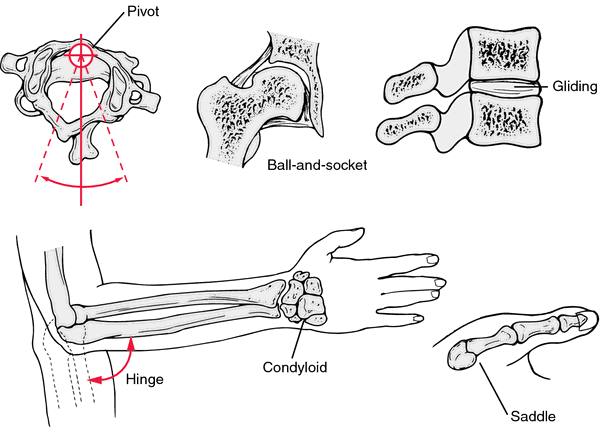joint
[joint]the site of the junction or union of two or more bones of the body; its primary function is to provide motion and flexibility to the frame of the body. Some are immovable, such as the sutures where segments of bone are fused together in the skull. Others, such as those between the vertebrae, are gliding joints and have limited motion. However, most joints allow considerable motion. The most common type are the synovial joints, which have a complex internal structure, composed not only of ends of bones but also of ligaments, cartilage, the articular capsule, the synovial membrane, and sometimes bursae.
acromioclavicular joint the point at which the clavicle joins with the acromion.
ankle joint the joint between the foot and the leg; see ankle.
arthrodial joint gliding joint.
ball-and-socket joint a synovial joint in which the rounded or spheroidal surface of one bone (the “ball”) moves within a cup-shaped depression (the “socket”) on another bone, allowing greater freedom of movement than any other type of joint. See illustration. Called also polyaxial or spheroidal joint.
bicondylar joint a condylar joint with a meniscus between the articular surfaces, as in the temporomandibular joint.
cartilaginous joint a type of synarthrosis in which the bones are united by cartilage, providing slight flexible movement; the two types are synchondrosis and symphysis.
composite joint (compound joint) a type of synovial joint in which more than two bones are involved.
condylar joint (condyloid joint) one in which an ovoid head of one bone moves in an elliptical cavity of another, permitting all movements except axial rotation; this type is found at the wrist, connecting the radius and carpal bones, and at the base of the index finger. See illustration.
diarthrodial joint synovial joint.
ellipsoidal joint condylar joint.
facet j's the articulations of the vertebral column.
fibrous joint a joint in which the union of bony elements is by continuous intervening fibrous tissue, which makes little motion possible; the three types are suture, syndesmosis, and gomphosis. Called also immovable or synarthrodial joint and synarthrosis.
flail joint an unusually mobile joint, such as results when joint resection is done to relieve pain.
glenohumeral joint the synovial joint formed by the head of the humerus and the glenoid cavity of the scapula. Called also humeral joint and shoulder joint.
gliding joint a synovial joint in which the opposed surfaces are flat or only slightly curved, so that the bones slide against each other in a simple and limited way. The intervertebral joints are this type, and many of the small bones of the wrist and ankle also meet in gliding joints. Called also arthrodial joint and plane joint.
hinge joint a synovial joint that allows movement in only one plane, forward and backward. Examples are the elbow and the interphalangeal joints of the fingers. The jaw is primarily a hinge joint but it can also move somewhat from side to side. The knee and ankle joints are hinge joints that also allow some rotary movement. See illustration. Called also ginglymus.
hip joint the synovial joint formed at the head of the femur and the acetabulum of the hip. See illustration at hip.
humeral joint glenohumeral joint.
immovable joint fibrous j.
pivot joint a synovial joint in which one bone pivots within a bony or an osseoligamentous ring, allowing only rotary movement; an example is the joint between the first and second cervical vertebrae (the atlas and axis). See illustration. Called also rotary or trochoid joint.
plane joint gliding joint.
polyaxial joint ball-and-socket joint.
rotary joint pivot joint.
sacroiliac joint the joint between the sacrum and ilium in the lower back; see also sacroiliac joint.
saddle joint a synovial joint whose movement resembles that of a rider on horseback, who can shift in several directions at will; there is a saddle joint at the base of the thumb, so that the thumb is more flexible and complex than the other fingers but is also more difficult to treat if injured.
shoulder joint humeral joint.
simple joint a type of synovial joint in which only two bones are involved.
spheroidal joint ball-and-socket joint.
synarthrodial joint fibrous j.
synovial joint a specialized joint that permits more or less free movement, the union of the bony elements being surrounded by an articular capsule enclosing a cavity lined by synovial membrane. Called also articulation and diarthrosis. A capillary network in the synovial membrane provides nutrients and synovial fluid to nourish and lubricate the joint space. Strong fibrous bands or cords (ligaments) give strength and security to synovial joints. The majority of the body's joints are of this type. They are divided into five types according to structure and motion: ball and socket, gliding, saddle, hinge, and pivot.

Joints.
trochoid joint pivot joint.
temporomandibular joint (TMJ) a bicondylar joint formed by the head of the mandible and the mandibular fossa, and the articular tubercle of the temporal bone. See also temporomandibular joint disorder.
Miller-Keane Encyclopedia and Dictionary of Medicine, Nursing, and Allied Health, Seventh Edition. © 2003 by Saunders, an imprint of Elsevier, Inc. All rights reserved.
hinge joint
[TA]a uniaxial joint in which a broad, transversely cylindric convexity on one bone fits into a corresponding concavity on the other, allowing of motion in one plane only, as in the elbow.
Synonym(s): ginglymus [TA], ginglymoid joint
Farlex Partner Medical Dictionary © Farlex 2012
hinge joint
(hinj joynt) [TA]A uniaxial joint in which a broad, transversely cylindric convexity on one bone fits into a corresponding concavity on the other, allowing of motion in one plane only.
Synonym(s): ginglymoid joint, ginglymus.
Synonym(s): ginglymoid joint, ginglymus.
Medical Dictionary for the Health Professions and Nursing © Farlex 2012
hinge joint
(hinj joynt) [TA]A uniaxial joint in which a broad, transversely cylindric convexity on one bone fits into a corresponding concavity on the other, allowing of motion in one plane only.
Synonym(s): ginglymoid joint, ginglymus.
Synonym(s): ginglymoid joint, ginglymus.
Medical Dictionary for the Dental Professions © Farlex 2012